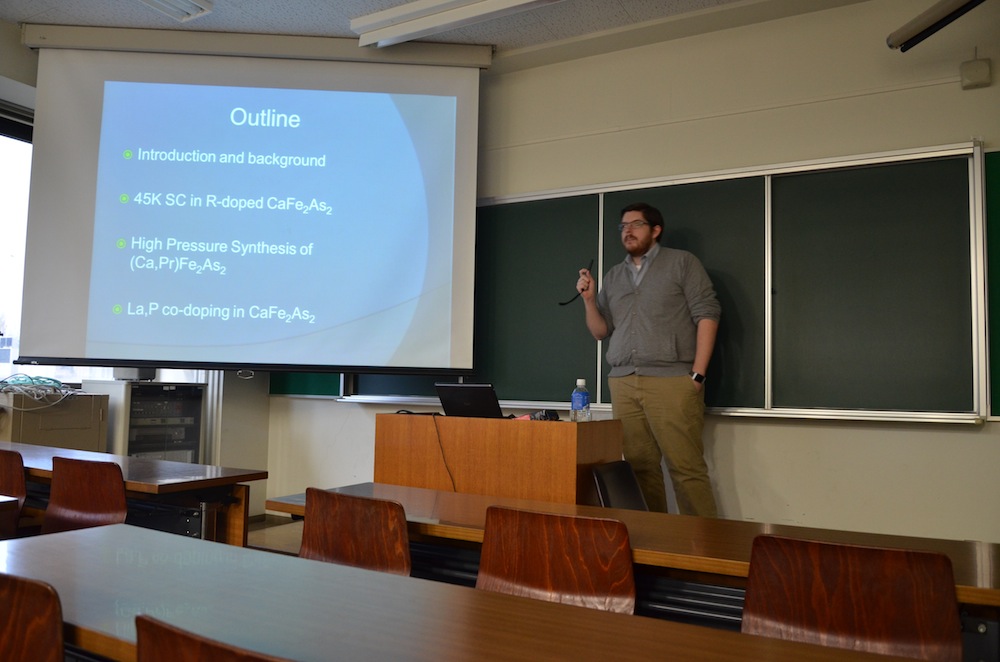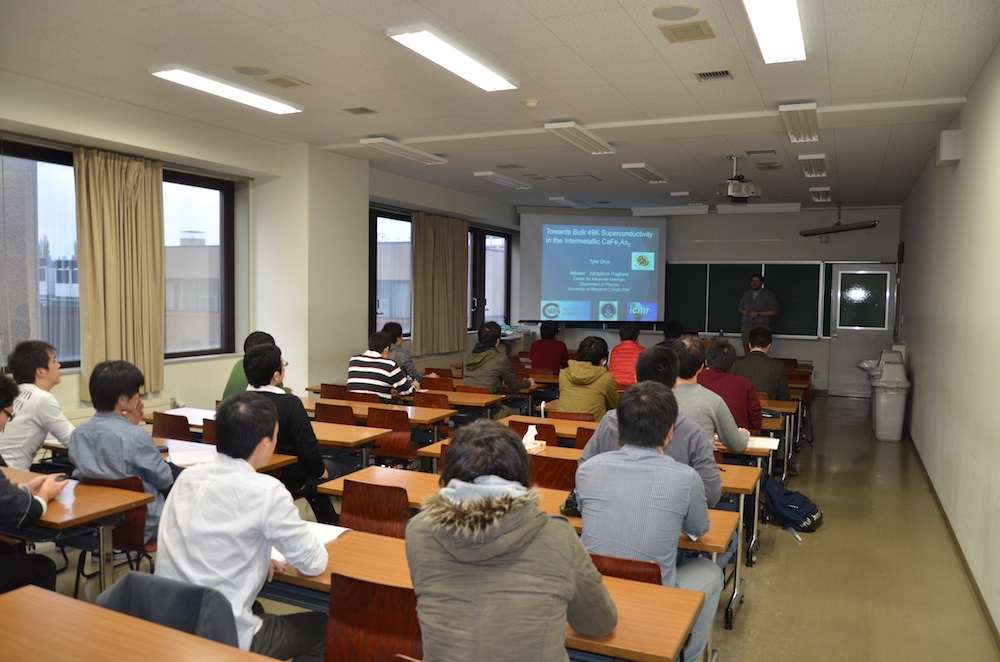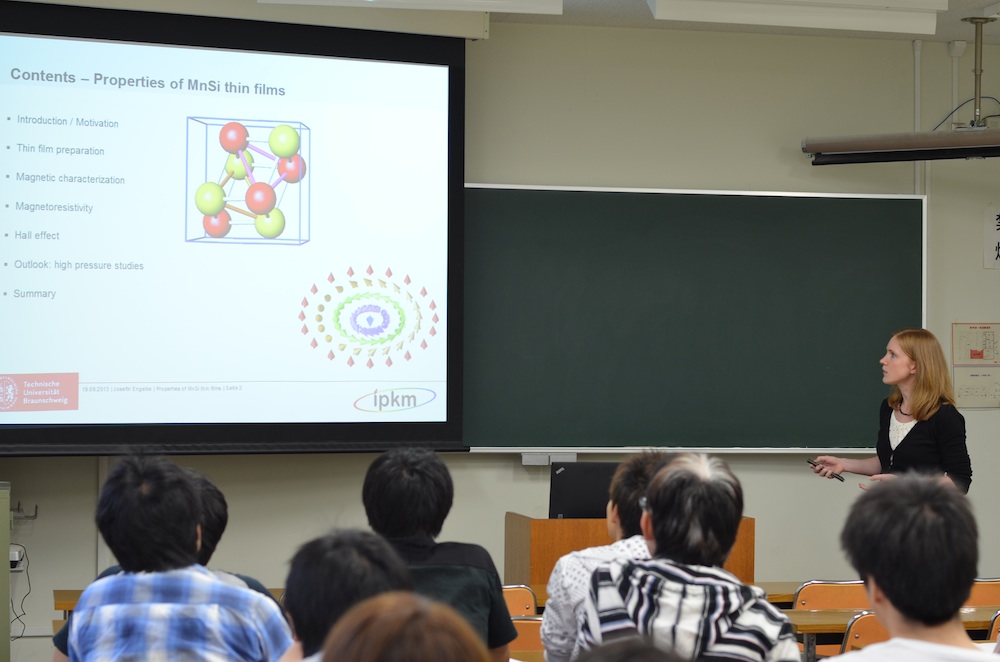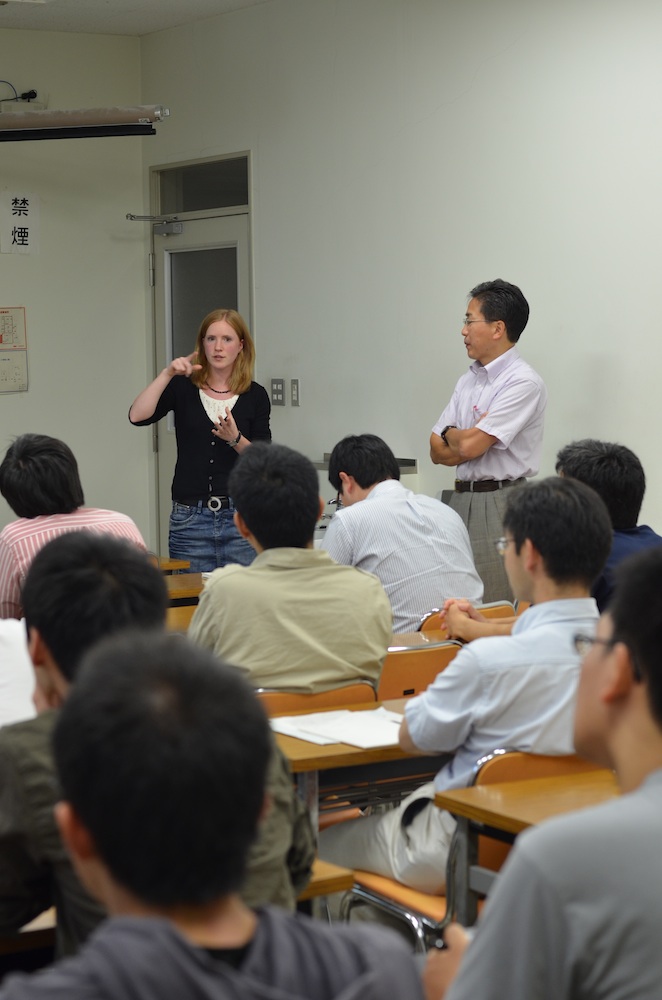日本物理学会北海道支部 講演会
講演会のアナウンスは支部会員のメーリングリストで行われます。 支部講演会・共催の講演会のお申し込みは、支部役員までご連絡下さい。
支部講演会の過去ログは、右バナーのArchivesからご覧ください。
最近5回分の講演リストを以下に表示します。
2025/02/19 「希土類ハニカム化合物RPt6Al3における時間反転対称性の破れた反強磁性秩序とピエゾ磁気効果」 大石遼平氏
2025/01/24 "Fractionalized excitations probed by ultrasound" Dr. S. Zherlitsyn
2024/12/13 「強磁場量子極限下のトポロジカル半金属における量子化熱電ホール効果の探索」
長田 俊人 氏
2024/11/26 「光の量子性を用いた計測技術」
岡本 亮 氏
2024/10/11 「Specifics of spin excitations in centrosymmetric helimagnets」
Dmytro S. Inosov 氏
2025/01/24 "Fractionalized excitations probed by ultrasound" Dr. S. Zherlitsyn
2024/12/13 「強磁場量子極限下のトポロジカル半金属における量子化熱電ホール効果の探索」
長田 俊人 氏
2024/11/26 「光の量子性を用いた計測技術」
岡本 亮 氏
2024/10/11 「Specifics of spin excitations in centrosymmetric helimagnets」
Dmytro S. Inosov 氏
「パリティの自発的破れがもたらす特異な電子状態」
楠瀬 博明氏
Feb 14, 2014
日本物理学会北海道支部講演会
トポロジー理工学教育研究センター第197回エンレイソウの会共催
講演題目: パリティの自発的破れがもたらす特異な電子状態
講 師 : 楠瀬 博明氏
愛媛大学大学院理工学研究科 准教授
日 時 : 平成26年2月14日 (金) 16:30-18:00
場 所 : 北海道大学理学部5号館206室(5-2-06)
要 旨 :
空間・時間反転対称性は固体中の電子状態の性質を強く制限している。 これらの自発的な破れが発生すれば、通常の磁性体のように、新しい物性を生み出すと期待される。 特に、スピン軌道相互作用がある系では、磁気と電気の間の非対角な応答が発生する。 本講演では、蜂の巣格子のような交替的に反転対称性のない系に着目して、反強磁性などの秩序が 空間反転対称性の自発的破れを誘発すること、その結果、生じる反対称スピン軌道相互作用もしくは 反対称スカラー場が電気磁気効果やスピン伝導などの非対角な応答に特異な影響を及ぼすこと、 を紹介する。特に、蜂の巣格子における2軌道ミニマル模型の解析結果を中心に議論したい。
世話人 柳澤達也
(tatsuya@phys.sci.hokudai.ac.jp)
北海道大学大学院理学研究院物理学部門
"Towards Bulk 49K Superconductivity in the Intermetallic CaFe2As2"
Mr. Tyler Drye
Nov 18, 2013
日本物理学会北海道支部講演会
トポロジー理工学教育研究センター第195回エンレイソウの会共催
講演題目: Towards Bulk 49 K Superconductivity in the Intermetallic CaFe2As2
講 師 : Mr. Tyler Drye
Department of Physics, University of Maryland College Park
(Visiting scholar by ICMR International Research Fellowship)
日 時 : 平成25年11月18日 (月) 15:00-16:00
場 所 : 北海道大学理学部2号館409室(2-4-09)
要 旨 :
The highest achievable superconducting critical temperature (Tc) in intermetallic iron-pnictide superconductors (specifically, the 122 family) was heald to be 39K when K is substituted for Ba in BaFe2As2. Our group was among the first to report traces of superconductivity in the 40-50K range when rare earth elements are doped for Ca in CaFe2As2. Unfortunately, these materials display a drastically low shielding volume fraction and correspondingly low critical current densities. Recent studies aimed at increasing this volume fraction, including high pressure synthesis and unusual doping schemes, have met with varying levels of success. This talk will detail these efforts and the outlook for bulk superconductivity in this system.
世話人 柳澤達也
(tatsuya@phys.sci.hokudai.ac.jp)
北海道大学大学院理学研究院物理学部門
 |
 |
「メゾスコピック超伝導体におけるボルテックダイナミクス」
宇治 進也 氏
Oct 23, 2013
北大理学部物理学部門主催、日本物理学会北海道支部講演会・ 第194回エンレイソウの会共催
講演題目: メゾスコピック超伝導体におけるボルテックダイナミクス
講 師 : 宇治 進也 氏
物質・材料研究機構 超伝導物性ユニット ユニットリーダー
日 時 : 平成25年10月23日 (水) 16:30-17:30
場 所 : 北海道大学理学部2号館211室(2-2-11)
要 旨 :
超伝導性を特徴づけるコヒーレンス長や磁場侵入長が、試料サイズと同程度になるメゾスコピック超伝導体では、試料の形状・境界条件が超伝導状態に大きく影響を与え(サイズ効果)、バルクの試料とは異なったメゾスコピック系特有の振る舞いが観測される。金属アルミニウムはバルクでは第一種の超伝導体であるが、 微小構造体では、そのサイズ効果により、第二種の超伝導体のように振る舞い、磁場中でボルテックス状態が形成される。電流を流すと、ボルテックスが駆動され、そこでエネルギーが散逸する。バルクでは、この散逸による抵抗は常伝導状態での抵抗を超えることはあり得ない。しかしメゾスコピック試料では、常伝導状態での抵抗の8倍もの大きさになることもあり、これには特異的なボルテックスのダイナミクスが関係している。この実験的な検証とメカニズムについて議論したい。
世話人 松永悟明
北海道大学大学院理学研究院物理学部門
"Magnetic and transport properties of MnSi thin films"
Ms. Josefin Engelke
Sep 19, 2013
トポロジー理工学教育研究センター第192回エンレイソウの会 ・ 物理学会北海道支部講演共催
講演題目: Magnetic and transport properties of MnSi thin films
講 師 : Ms. Josefin Engelke
Technische Universitat Braunschweig, Institute for Condensed Matter Physics, 38106 Braunschweig, Germany
日 時 : 平成25年9月19日 (木) 15:00-16:00
場 所 : 北海道大学理学部2号館211室(2-2-11)
要 旨 :
MnSi offers a variety of different magnetic phases. The competition of ferromagnetic exchange with the Dzyaloshinskii-Moriya interaction causes a helical spin structure as the ground state of the system. In applied magnetic fields a conical structure and ferromagnetic spin alignment can be observed. In addition, a skyrmion lattice phase occurs in a small field and temperature region close to the ordering temperature, which is known as the A-phase. In thin films a larger skyrmionic phase is expected in the magnetic phase diagram due to surface effects and strain. Using molecular beam epitaxy MnSi thin films have been grown on Si(111) substrates. Magnetization and magnetoresistivity measurements have been carried out and related to the magnetic phase diagram. The magnetic ordering temperature T_ord is enhanced and shows a thickness dependence. In comparison to bulk MnSi also the critical magnetic fields of the thin films are enhanced. Furthermore several features can be identified occuring in the magnetization as well as in the magnetoresistivity measurements, which are not present in bulk material. Potentially these are indications of an enlarged skyrmionic phase.
Reference: "Spin-spin correlation length in MnSi thin film", J. Engelke, T. Reimann, L. Hoffmann, S. Gas, S. Sullow, D. Menzel, J. Phys. Soc. Jpn. 81 (2012) 124709.
世話人 網塚 浩
(amiami@phys.sci.hokudai.ac.jp)
北海道大学大学院理学研究院物理学部門
 |
 |
"Stable localized structures in one and two spatial dimensions: a review and a perspective"
Prof. Helmut R. Brand
Aug 19, 2013
講演題目: Stable localized structures in one and two spatial dimensions: a review and a perspective
講 師 : Prof. Helmut R. Brand
Technische Universitat Braunschweig, Institute for Condensed Matter Physics, 38106 Braunschweig, Germany
日 時 : 平成25年8月19日 (木) 13:00-14:00
場 所 : 北海道大学理学部2号館211室(2-2-11)
要 旨 :
We give an overview over stable localized solutions in nonlinear driven non-equilibrium systems, often denoted as dissipative solitons [1]. We cover different mechanisms to generate stable localized structures in various types of prototype equations, namely, envelope equations, order parameter equations and phase equations.For envelope equations nonvariational effects are a key ingredient as emphasized first by Thual and Fauve [2]. This mechanism turns out to be very robust and allows for many different stable particle- and hole-like solutions in one and two spatial dimensions. The interaction of localized solutions can give rise to many different types of outcomes including propagating holes as a result of a collision of propagating particles of fixed shape [3]. For order parameter equations a trapping mechanism can generate localized solutions of arbitrary lengths [4]. A third type of localized solutions involves nonlinear phase dynamics giving rise to stable localized patterns in the wavelength for a nonlinear phase equation [5] or in coupled envelope and phase equations [6]. We also cover briefly recent work on the effects of noise on localized solutions in envelope equations [7,8] and close with an overview of possible applications to systems as diverse as surface reactions under UHV conditions [9], binary fluid convection [10] or holes observed in corn and potato starch suspensions [11].
[1] N. Akhmediev and A. Ankiewicz, Eds., Dissipative Solitons, Springer, Heidelberg (2005).
[2] O. Thual and S. Fauve, J.Phys. France 49, 1829 (1988).
[3] O. Descalzi, J. Cisternas, and H.R. Brand, Phys. Rev. E 74, 065201 (2006).
[4] H. Sakaguchi and H.R. Brand, Physica D 97, 274 (1996).
[5] H.R. Brand and R.J. Deissler, Phys. Rev. Lett. 63, 508 (1989).
[6] H. Sakaguchi, Prog. Theor. Phys. 87, 1049 (1992).
[7] O. Descalzi, J. Cisternas, D. Escaff, and H.R. Brand, Phys. Rev. Lett. 102, 188302 (2009).
[8] C. Cartes, J. Cisternas, O. Descalzi, and H.R. Brand, Phys. Rev. Lett. 109, 178303 (2012).
[9] H.H. Rotermund, S. Jakubith, A. von Oertzen, and G. Ertl, Phys. Rev. Lett. 66, 3083 (1991).
[10] P. Kolodner, Phys. Rev. A 44, 6448 (1991); Phys. Rev. A 44, 6466 (1991).
[11] H. Ebata and M. Sano, Phys. Rev. Lett. 107, 088301 (2011).
世話人 北 孝文
(kita@phys.sci.hokudai.ac.jp)
北海道大学大学院理学研究院物理学部門
